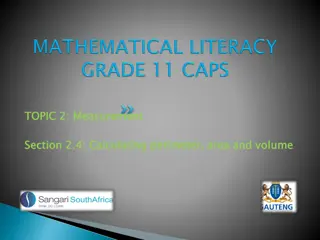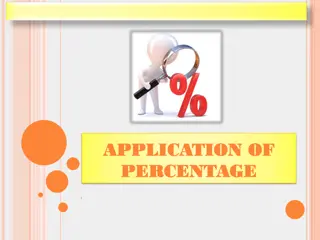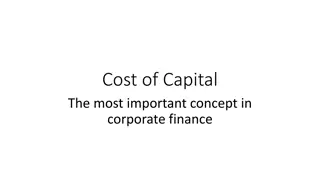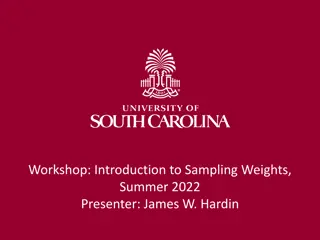Economic Framework for Greenhouse Gases: Recent Insights
A comprehensive analysis of the social cost of greenhouse gases, including recent RFF research and EPA estimates, using a stochastic discounting approach. Explore a modular framework for calculating the SCC and RFF Socioeconomic Projections on global CO2 emissions and economic growth. Learn about th
0 views • 17 slides
A Corporate Accounting and Reporting Standard
This standard covers corporate accounting and reporting principles, tracking emissions over time, calculating emissions, and reporting GHG emissions.
2 views • 18 slides
Avian Hazard Advisory System (AHAS) Update
The latest updates to the Avian Hazard Advisory System (AHAS) providing crucial bird hazard information for flight safety. Learn about calculating NEXRAD risk, regional mosaics, flying areas, and risk management.
0 views • 23 slides
A Corporate Accounting And Reporting Standard
Principles and guidelines for preparing GHG emissions inventories, focusing on organizational boundaries, operational boundaries, tracking emissions over time, calculating emissions, and reporting GHG emissions. It emphasizes relevance, completeness, consistency, transparency, and accuracy in accoun
1 views • 14 slides
A Corporate Accounting and Reporting Standard
This training curriculum covers principles of GHG accounting, organizational boundaries, setting operational boundaries, tracking emissions over time, calculating emissions, and reporting GHG emissions. It emphasizes the importance of determining which company operations and emissions sources to inc
2 views • 25 slides
HOW TO RETIRE WITH THE VIRGINIA RETIREMENT SYSTEM
Explore retirement eligibility, calculating benefits, payout options, healthcare, and more under the Virginia Retirement System (VRS) Plan. Understand the defined benefit plan, retirement criteria for VRS Plan 1 and Plan 2, as well as strategies for calculating unreduced benefits. Get insights into
2 views • 37 slides
Calculating Car Transport by Train Cost Using Cost Calculators
When it comes to calculating the\u00a0car transport by train cost, you might be unaware of the key components that are creating the actual difference. Read the blog, we have listed a few of them that you can use to make close estimations for future moves.\n
6 views • 2 slides
Understanding Tax Tables, Worksheets, and Schedules for Federal Income Taxes
Explore the concept of tax tables, worksheets, and schedules for calculating federal income taxes. Learn how to express tax schedules algebraically and compute taxes using IRS resources. Examples featuring single and married taxpayers provide practical insights into determining taxable income and ca
0 views • 11 slides
Solving Money Problems with Arithmetic
This chapter focuses on applied arithmetic concepts such as calculating mark-up, margin, compound interest, income tax, and net pay. It covers topics like percentages, income, deductions, and income tax rates in Ireland. Detailed examples on calculating tax payable, deductions, and net pay are provi
0 views • 12 slides
Understanding Measurement: Calculating Perimeter, Area, and Volume
Dive into the world of measurement with a focus on calculating perimeter, area, and volume for shapes like rectangles, triangles, circles, and prisms. Learn key formulas and methods to determine these crucial metrics through practical examples and step-by-step calculations.
1 views • 34 slides
Calculus I Lecture #13: Volumes of Solids and Solids of Revolution
Exploring the concepts of finding volumes of solids using integrals, by slicing solid objects with parallel planes and calculating cross-sectional areas. Examples include calculating the volume of a pyramid and a curved wedge. The method of solids of revolution using the disk method is also discusse
0 views • 12 slides
Calculation of Radiation on Sloped Surfaces
The general problem of calculating radiation on tilted surfaces when only the total radiation on a horizontal surface is known involves determining the direction from which the beam and diffuse components reach the surface. Diffuse radiation models consist of three parts: isotropic, circumsolar, and
1 views • 15 slides
Understanding Energy - Forms, Calculations, and Applications
Explore the concept of energy through various images, including forms of energy, kinetic versus potential energy, and calculations involving kinetic and potential energy. Learn about identifying energy states, calculating kinetic energy, and solving physics problems related to energy transfer. Dive
0 views • 27 slides
Calculating Envelope Energy Loss in Weatherization Energy Auditor Training
Learning objectives in a standardized curriculum for the Weatherization Assistance Program focus on defining energy movement, calculating hourly and annual energy loss, and understanding diminishing returns. The content covers quantifying envelope energy loss, key terms like BTU and R-value, typical
0 views • 23 slides
Understanding Superposition Theorem in Electrical Circuits
Superposition theorem in electrical circuits states that the effects of multiple voltage and current sources in a network can be analyzed independently and then combined algebraically. This allows for calculating the voltage and current distribution in a network more efficiently. The theorem involve
0 views • 9 slides
Understanding Percentages in Everyday Life
Percentages play a significant role in our daily activities, from calculating discounts in shops to determining financial interests. This lesson covers converting percentages to fractions, decimals, and ratios, applying percentages in practical scenarios, calculating profit or loss percentages, and
0 views • 31 slides
Parallel Chi-square Test for Feature Selection in Categorical Data
The chi-square test is a popular method for feature selection in categorical data with classification labels. By calculating chi-square values in parallel for all features simultaneously, this approach provides a more efficient solution compared to serial computation. The process involves creating c
1 views • 4 slides
Understanding Circular Motion: Co-Terminal Angles and Radian Measure
Explore the concept of co-terminal angles in circular motion, finding lengths of circular arcs, understanding linear and angular speed, and calculating radian measures. Dive into examples of finding co-terminal angles, determining arc lengths, and converting angles to radians. Discover the relations
2 views • 13 slides
Understanding Cosine Similarity in Inverted Index for Querying
In this document, Dr. Claudia Pearce explains how to build and query from an inverted index, focusing on calculating the Cosine Similarity. The process involves calculating the dot product of terms in the document and query, updating sums based on term weights, and understanding the significance of
0 views • 15 slides
Calculating Areas of Geometric Shapes
Explore the concept of finding the area of trapezoids, rhombuses, kites, and regular polygons using visual aids and explanations. Learn about the measurements needed, such as base, height, apothem, and more, to determine the area accurately. Practice calculating areas of various polygons like decago
0 views • 17 slides
Calculating Limiting Reagent in Chemical Reactions
Calculating the amount of reactants in excess and the limiting reagent plays a crucial role in determining the maximum extent of a chemical reaction. By using the relative numbers of moles of substances as shown in balanced equations, one can identify the reactant that is fully utilized, hence limit
0 views • 14 slides
Setting Stocking Rate: Four-Step Procedure for Balancing Supply with Demand
To set stocking rates effectively, follow a four-step procedure that involves balancing supply with demand. This method helps estimate carrying capacity, adjust for changes in animal types, and more. The process includes calculating usable forage, adjusting for terrain accessibility, determining for
0 views • 25 slides
Calculating Maximum Power Delivery to Load in Current Steering DACs
In the process of calculating the maximum power delivered to the load for current steering DACs, several steps are involved, such as determining the peak-to-peak voltage at the DAC output, converting it to RMS voltage, calculating power delivered to the load, and converting power to dBm. Examples wi
0 views • 5 slides
Understanding Olivine Equilibrium in Calculating Original Magma Composition
The process involves analyzing olivine in basaltic rocks, selecting olivine with the highest Fo content, calculating the melt composition in equilibrium with this olivine using the distribution coefficient (KD), and determining the potential temperature (Tp) based on the MgO content. The distributio
0 views • 30 slides
Sports Official Selection and Evaluation Process Overview
The process for selecting and evaluating sports officials involves various steps such as rating on a 1-5 scale, calculating mean, median, and mode of ratings, and voting by coaches and associations. Athletic Directors play a crucial role in submitting their ballots at the end of the season. Official
0 views • 23 slides
Challenging Math Word Problems for Elementary Students
These math word problems challenge elementary students with scenarios like calculating the cost of multiple items, determining the number of teachers on a field trip, finding daily production rates, calculating total weights, and more. The problems involve real-life situations to make learning engag
0 views • 10 slides
Physics Chapter 23 Problems Solutions
Explore solutions to various physics problems from Chapter 23, including calculating electric forces between protons, resultant electric force on charges, mass of charged objects in electric fields, electric field and forces between point charges, and calculating particle speeds in electric fields.
0 views • 17 slides
Polar Curves: Intersections, Areas, and Calculating Enclosed Areas
Explore polar curves, their intersections, areas enclosed by curves, and calculating enclosed areas using given equations. Learn to sketch graphs, find points of intersection, polar coordinates, and apply formulas for finding enclosed areas with examples provided.
0 views • 21 slides
Understanding Internal Rate of Return (IRR) in Investments
Internal Rate of Return (IRR) is a method used to assess the profitability of potential investments by calculating the discount rate that makes the net present value of an investment zero. It considers the time value of money and helps in comparing projects based on their returns relative to costs.
0 views • 5 slides
Tuning and Matching of 1 and 2 Loops Antenna
The aim of the project is to match the impedance of the circuit to 50 ohms at the resonance frequency of 14.8 MHz. The process involves calculating the impedance, working at low frequencies to determine key parameters, calculating capacitors, determining Q, and finally calculating tuning and matchin
0 views • 25 slides
Measurement Progression in Skills: Comparing, Estimating, Measuring, and Calculating
Explore the progression of measurement skills from Year 1 to Year 6, covering concepts like comparing lengths, mass, time, and volume, estimating measures including money, calculating areas of shapes and volumes of objects, sequencing events in chronological order, and much more. Enhance skills in c
0 views • 6 slides
Circumference and Perimeter Calculations in Geometry
Explore various geometry problems involving calculating circumferences and perimeters of shapes and circles. Practice calculating diameters, radii, and distances moved in real-life scenarios. Test your knowledge with true or false questions related to geometry concepts.
0 views • 12 slides
Understanding Z-Scores in Data Analysis
Z-Scores are standardized measurements that indicate how far a data value is from the mean in a dataset. By calculating Z-scores, analysts can compare different data points and understand their relative positions within the distribution. This summary covers the concept of Z-scores, how to calculate
0 views • 19 slides
Understanding Improper Payment Rate Calculation Process
Dive into the detailed process of calculating improper payment rates, including the thorough approval process, focusing on projected dollars in error, and analyzing error trends. Learn about determining weights, calculating projected dollars, and adding up projected improper payments in different st
0 views • 17 slides
Understanding the Significance of Cost of Capital in Corporate Finance
Cost of capital is a fundamental concept in corporate finance introduced by Modigliani and Miller in 1958. It involves calculating the Weighted Average Cost of Capital (WACC) as a combination of debt and equity costs to determine asset value. Despite discrepancies in calculating asset values, WACC r
0 views • 100 slides
Understanding Different Methods for Calculating Averages
Exploring two distinct ways of organizing data for calculating averages using household income as an example. Learn how to compute the mean in both scenarios and dive into the mathematical formulas involved.
0 views • 19 slides
Understanding Motion and Newton's Laws
Explore the concepts of motion, distance, speed, and velocity as they relate to Newton's Laws of Motion. Learn about measuring motion, calculating speed, graphing motion on distance-time graphs, and understanding velocity. Discover how motion is constant and how relative motion is used. Practice cal
0 views • 36 slides
Polymer Molecular Weight Exercise Analysis
This exercise involves calculating the number average and weight average molecular weights, as well as the polydispersity index (PDI) for a sample of polystyrene composed of fractions with different molecular weights. The analysis includes determining the number of moles in each fraction, calculatin
0 views • 7 slides
Understanding Probability: Learning Outcomes and Examples
This content delves into the study of probability, covering topics such as representing probabilities of simple and compound events, calculating relative frequencies, multi-step chance experiments, theoretical and experimental probabilities. It explains concepts like chance experiments, sample space
0 views • 31 slides
Calculating Polygon Area and Trapezium Area with Known Coordinates
The content above guides you on finding the exact area of a polygon by calculating the areas of individual triangles within it. It also demonstrates how to list coordinates in a spreadsheet, calculate the area of trapeziums formed by pairs of coordinates, and sum their areas to determine the total a
0 views • 28 slides







































